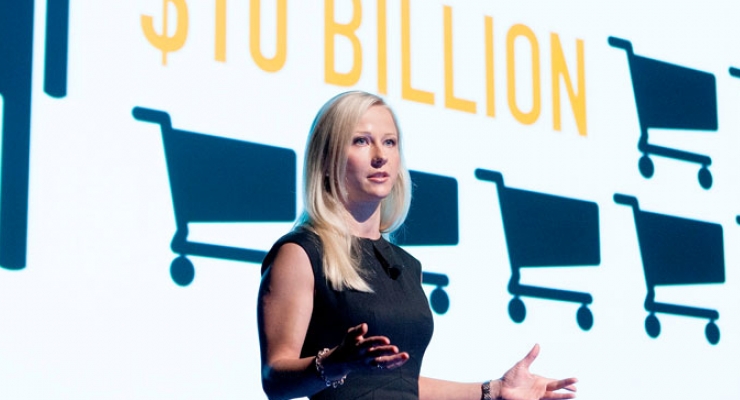Jamie Matusow, Editor06.09.14
|
Natalia Espejo at FIT's CFMM Capstone research unveiling, in partnership with Unilever U.S. (PRNewsFoto/Unilever U.S.) |
This year’s Capstone presentation was held on June 4, at FIT, and was sponsored by Unilever for the second consecutive year. About 700 industry professionals packed the auditorium for this popular annual event.
The 2014 Capstone research focused on the continuing evolution of the beauty industry, with the theme "The Changing Face of the Beauty Consumer." Three key areas—Accessible Beauty, The New Beauty Consumer, and Men's Beauty and Grooming—were evaluated. Students in the 2014 graduating class presented their research findings via an engaging series of visuals and short presentations.
Keynote Speaker
Gina Boswell, executive vice president Personal Care, Unilever NA, delivered the keynote address. She said at Unilever, Personal Care encompasses Beauty. “We believe that people are beautiful, not made beautiful—and beautiful inside and out. So the Personal part comes from making individual lives better.”|
Renee Bukowski at FIT's CFMM Capstone research unveiling, in partnership with Unilever U.S. (PRNewsFoto/Unilever U.S.) |
Boswell said consumers are more demanding than ever. She told the crowd that 66% of millennials, ages 18-29, do not have full-time jobs, yet still demand more from brands. “They have the ‘I do what I want when I want’ mentality, and look at their purchases in the same way,” she said. In addition, as far as emerging consumers, Boswell said in the future, ethnic consumers will account for 1 out of 2. And in Men’s beauty, she said, we can look to higher growth, although it will still be a small piece of the beauty pie.
She said “Seismic shifts like this call for seismic activity changes.” What does tomorrow look like? Boswell said we face a dramatic new landscape in 2030, one in which the population of Asia will surpass that of North America and Europe together. By 2020, she said, many countries will also have aging populations, over 45 years old. The number of impoverished peoples will have declined and they will have become consumers. And people will become increasingly global.
Progressive Rationalists
Next, the students began presenting the details they had unearthed in their think tank research.
They identified the new consumers as Progressive Rationalists. By 2030, these individuals will trade up—and down, depending on what’s specifically important to them. They will make purchases in a different way because they will be tech-savvy, conscious of brands and pricing. Their Need will be the Hero, explained the students. Convenience, clarity and cash will be the most important features for a brand to offer, as consumers will no longer tolerate wasting money.
One possibility to move forward successfully: Beauty brands, the research suggested, should engage with local franchises in order to be hyper accessible.
Token philanthropy will not be enough for these consumers who will be looking for significant social responsibility on brands’ parts. Brands will have to authentically contribute to society in order to be important to consumers.
In looking ahead to tomorrow’s consumer, students urged beauty brands to “think about your category in a new way.” They also said it is a great time for private label brands, citing the growth of Sephora’s private label lines.
The Future of ‘Others’
Not only will consumers of the future have different habits and values, their very essence will have changed.
As Boswell had pointed out in her keynote, the population will become older and more ethnic. In addition, students said, there will most likely be more working women than men, and the LGBT community will have grown. In other words, “sex will be collapsing into a number of gender attributes.”
Skin tones and physical features are bound to change as different ethnic groups blend. By 2050, the Capstone research predicts that recessive traits like red hair and freckles will disappear. And a new tone will be born every day.
Facebook, they pointed out, has 56 profile options other than just male or female.
“We need to find the common thread between culture and race,” they stressed.
Students offered four key questions for beauty companies to ask in trying to meet these new consumers’ needs:
- How can we engage consumers beyond demographics?
- How can we break through the clutter?
- How do we evolve along with technology?
- How do we develop and integrate an integral marketing strategy?
Successfully reaching out to “Others,” said the students, “will make or break the bottom line for beauty.”
Men’s Beauty
Men’s Beauty? Grooming? Skincare? Which term makes them feel the most comfortable? Whichever it is, the U.S. may not yet have hit upon it as we lag far behind many countries in the world when it comes to sales in the men’s market. South Korea leads them all with a 67% growth rate and men there are known to use as many as nine products a day.
The U.S. shows great potential though. While men have traditionally used purely practical products such as deodorant and bar soaps, it has been a challenge to get them interested beyond the basics.
Skincare, said the students, is the No. 1 opportunity for the men’s market. “We’re at a pivotal moment in this industry,” they emphasized.
“We need to change our mindset about men,” they said. They suggested igniting some type of movement to steer men toward beauty. One example they gave: As many women buy products for men, in South Korea, SK-II gave a premium-sized men’s GWP with every woman’s purchase. Another idea was to appeal to new imagery such as men’s masculinity being defined as being a good father, rather than a ‘he-man.’
“Now is the time for your brand to take action,” stressed the speakers. “Invest some R&D in men and cultivate a culture in which men can associate with beauty.”
The results are bound to pay off, according to the students. “If every man adds one product to their regimen, billions of dollars are there for the taking.”













